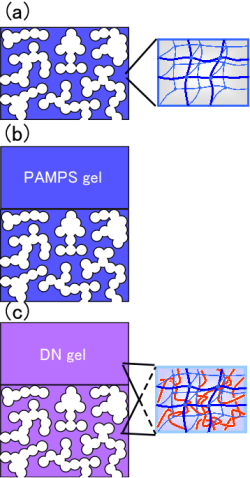Adhension of Double Network Gel
Most parts of the living body are made of gels, except for hard tissues such as teeth or bones. DN hydrogels are considered as attractive candidates for the fabrication of artificial cartilages because of their extremely high mechanical strength (fracture stress = 170 kg/cm2) and low friction. DN gels used in artificial cartilages must bond strongly with hydroxyapatite found in artificial bone; hence, it is necessary to fix the gels firmly onto a solid substrate.
We attempted to bond DN gels with porous solid substrates through a gradient structure.
- First, poly(2-acrylamido-2-methylpropanesulfonic acid) (PAMPS) gel, which is used to form the first network, is synthesized in voids in the porous solid substrate.
- Then, the porous solid substrate containing PAMPS gel is immersed in a solution of acrylamide (AAm) , which is used to form the second network. Subsequently, the porous solid is brought in contact with a portion of the PAMPS gel sheet, which is also soaked in the AAm solution.
- Thus, the poly(acrylamide) (PAAm) gel is simultaneously synthesized in both the porous solid substrate and in the PAMPS sheet.
This method results in a DN structure both in the porous solid substrate and in the gel sheet.

A strong interface between tough PAMPS/PAAm DN gels and various porous solid substrates is achieved via DN formation. It is found that the strength of the gel-substrate interface depends on the pore size of the solid substrates. Porous solids, with pore sizes in the order of several micrometers, result in the formation of strong gel-substrate interfaces. Under optimal conditions, the bonding strength between the gel and the substrate is comparable to the bonding strength of the bulk DN gel.
Reference
Takayuki Kurokawa, Hidemitsu Furukawa, Wei Wang, Yoshimi Tanaka, Jian Ping Gong, “Formation of a strong hydrogel-porous solid interface via the double-network principle,” Acta Biomaterialia, 6(4), 1353-1359(2010.4).

